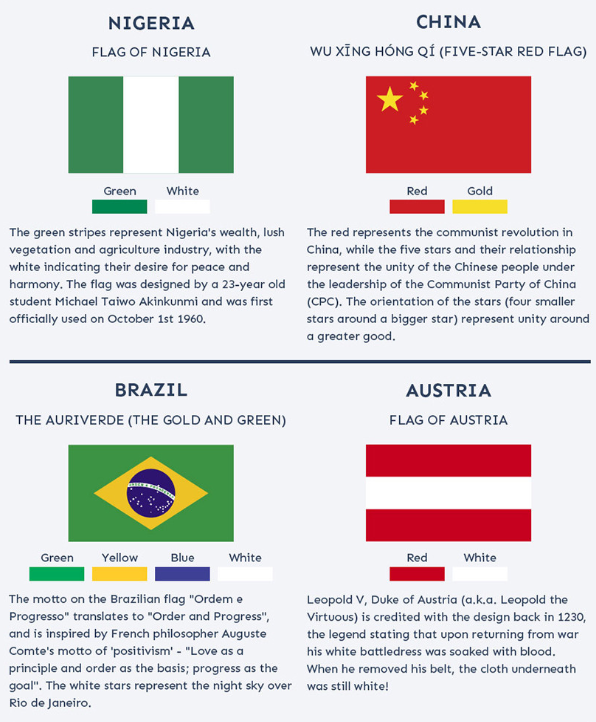This is what 24 of the world's most iconic flags mean

An infographic detailing the symbolic meaning behind the design of the most prominent national flags.
Image: REUTERS/Stephane Mahe - RC137B88F8B0
Stay up to date:
United States
From the skull and bones at the top of a pirate ship to a white flag on a battlefield, a single piece of fabric can be interpreted in a multitude of ways. Depending on where they fly, flags can represent freedom or control, danger or safety.
In the context of modern times, flags are best known as national symbols — and they’re used to air a country’s past, present, and future vision all rolled into one.
The Meaning of Flags
Today’s infographic from Just the Flight looks at some the world’s most iconic flags, and the intricate stories and ideals that can be found in their designs.
The Americas
Since 1777, the star-spangled banner of the United States has gone through several facelifts. The current version has been in use since Hawaii gained statehood in 1960. Puerto Rico has been voting to become the 51st state in recent years — and if the U.S. government proved to accept such a resolution, the flag would be amended once more.
The largest country in South America, Brazil adopted its flag design in 1889. The primarily green background represents its lush Amazonian forest while the yellow diamond signifies its wealth in gold. Meanwhile, the Portuguese slogan on the flag, Ordem e Progresso, is a nod to democracy.
Europe
Denmark holds the Guinness world record for the oldest continuous use of their national flag, since 1625. The Danish flag is known as the Dannebrog, or Danish Cloth — as legend has it, the Dannebrog ‘miraculously’ fell from the sky in a battle during the Northern Crusades.
The Union Jack of the United Kingdom combines aspects of three older national flags and was adopted in 1801. Displaying the flag upside down is considered lèse-majesté — “to do wrong to majesty”, or an insult to the Crown — and is offensive to some.
Asia and Oceania
India’s tricolor flag was first flown in 1923. However, the colors do not represent religions or hours in the day — saffron symbolizes indifference to material gains, the white band represents light while the navy blue Dharma Chakra (wheel of truth) depicts dynamic change, and green demonstrates the country’s relationship to nature.
New Zealand’s flag features elements from the British Commonwealth. Since 2015, there have been ongoing debates among Kiwis about whether to amend the flag’s design. Frequent confusion with Australia is a significant pro for change, but national identity and financial costs are strong arguments against it.
Nepal is the only country without a rectangular (or square) national flag. The two triangles pay tribute to its geographic location in the Himalayas as well as the Shah and Rana dynasties. The sun and moon symbols on the flag used to have human faces on them, but were removed in 1962.
Africa
South Africa boasts one of the world’s most colorful flags. When it was first adopted after Nelson Mandela’s release from prison, it was the first world flag to have six colors but no seal or brocade. Interestingly, while there is no inherent meaning in its colors, the Y shape symbolizes the convergence of diverse elements and societal unity.
Mozambique is the only national flag in the world to feature a modern weapon – specifically, an AK-47 with an attached bayonet. Adopted in 1983, the rifle represents vigilance and defense, while the hoe crossing it represents the country’s agriculture.
Don't miss any update on this topic
Create a free account and access your personalized content collection with our latest publications and analyses.
License and Republishing
World Economic Forum articles may be republished in accordance with the Creative Commons Attribution-NonCommercial-NoDerivatives 4.0 International Public License, and in accordance with our Terms of Use.
The views expressed in this article are those of the author alone and not the World Economic Forum.
Related topics:
Forum Stories newsletter
Bringing you weekly curated insights and analysis on the global issues that matter.
More on Geographies in DepthSee all
Yusuf Maitama Tuggar
July 10, 2025
Kaiser Kuo
June 24, 2025
Kaiser Kuo
June 19, 2025
Aimée Dushime
April 18, 2025
Samir Saran and Anirban Sarma
April 17, 2025
Nada AlSaeed
April 16, 2025











